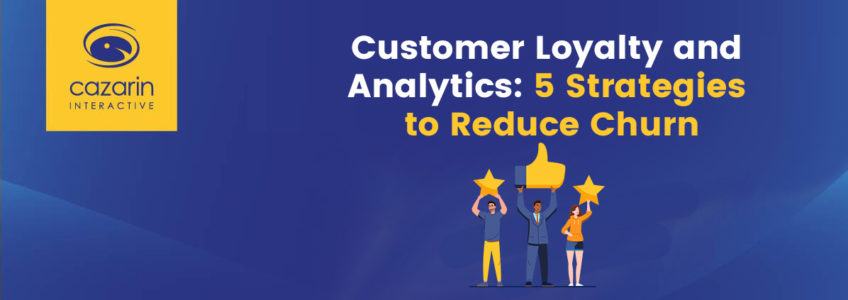
Think customer loyalty programs are all about getting generic discounts, points and rewards? Think again. Today, customer loyalty has become a major focus for brands as they Today, it’s more about offering customers something as personalized as possible, so that they feel truly special.In the globalized world of today, competition is cut-throat. Businesses are popping up everywhere, and customers have a variety of options available. In such a world, the experience becomes a huge differentiator. A good experience makes for long-term happy customers. A good understanding of your customers is the key to delivering such an experience. That’s where customer loyalty analytics can be very useful. With the help of big data, you can learn about your buyers and tailor an experience that matches their expectations. Customer loyalty analytics can also be useful in developing customer-centric marketing strategies that give a higher return on investment.
We are living in the age of the smart consumer; they know what they want, and they also know that if one business doesn’t provide it for them, there’s likely many others just a mouse click away that will. The crowded marketplace means that customers are less likely to remain loyal to one brand, and the advent of social media has also empowered consumers to share both positive and negative brand experiences online. E-commerce has provided customers with a plethora of opportunities and choices sitting right on their smart phone, which can be a positive for businesses who pay attention to their customers’ needs and a drawback to those who aren’t using customer data to empower their marketing strategy. If you’re not collecting and utilizing customer data in your efforts or are unsure of how to use analytics to boost your customer lifetime value (CLV), read on for some ideas.
Using Data The Smart Way
Marketers have been told for some time now that the key to creating more relevant, “sticky” campaigns is to use data to inform your content. But utility of data analytics goes beyond the campaign level. Today’s laser-focus on customer experience and journey means that data should be the backbone of your entire business strategy.
However, while many businesses may realize the star role that CX needs to play in their efforts, few truly know how to use data analytics to improve the experience and garner true customer loyalty. According to a recent study published by McKinsey, businesses’ use of analytics to create a competitive edge in customer experience is only at 32%. This demonstrates the issues that many businesses are having in trying to apply data in a universal, transactional way across their entire organization.
Great customer experiences lead to higher retention rates, increased brand loyalty, and bigger customer lifetime value (CLV). Improving customer experiences can seem like a straightforward task, but unless you base new tactics and strategies on tools like zero-party data, you might be putting in effort and resources in the wrong places.
So, what are some RIGHT ways to use data analytics to improve customer loyalty? Here’s 5 ideas to help you get started building that data-driven competitive edge.
1. Segment Customers The Smart Way
Today’s ultra-connected world means that both your current and new customers will interact with your brand through many different channels, but eventually, they will develop a preferred way in which they obtain the goods and services they need from you. These preferences provide valuable insights about themselves, their behaviors, their lifestyles, and even their future purchases and areas of need.
2. Nurture Leads
Once you begin using data to inform you on a customers’ interests, pain points, and preferences, consider sharing non-promotional content that’s meant to nurture them through the know-like-trust cycle. The more relevant the content, the more likely they are to remain on your outreach list and to convert into customers.
Consider this: 74% of today’s consumers state that they are more likely to patronize a brand that is vocal about their mission and their beliefs, and 78% more likely to follow a brand that shares their beliefs in altruistic and philanthropic endeavors.
If you’re a company involved in giving back to the community, has a commitment to a specific charity, or has a mission to lower their carbon footprint this is the time to let it be known, and not just with a quick note or mention on your Facebook. Include your efforts frequently in your online and social media content, and let it be known that you have a strong commitment to the new corporate consciousness.
3. Personalize
One of the best aspects of data analytics is how it can help you predict the future. By curating and analyzing data on your customers past purchases, wish lists, and even search information, you can provide personalized recommendations that make them feel you’re truly vested in their brand experience.
Just how important are personalized recommendations to the modern consumer? Look at Amazon’s audio book powerhouse, Audible for proof. For several years, Audible had provided recommended audiobook selections to their premium members based on their prior purchases, favorite authors, preferred story tropes, and even their ratings on narrators on the customized home page a member saw first on login. Audible decided to remove this “instant gratification” feature from members home pages for a time in order to promote their new “Audible Originals” content. Within a matter of days not only had they amassed a record number of complaints about the removal of this feature, they also had a record number of patrons cancel their premium memberships. Luckily, Audible realized their mistake and quickly pivoted to providing the personalized recommendations feature on their Audible app, but those customers who canceled their memberships in the interim will take lots of effort – and marketing dollars – to regain.
Using data to gain insight into customer preferences and suggest products and services that make their lives better demonstrates a brand that gets EXACTLY what customer experience is all about, and this builds a bridge of loyalty that keeps customers coming back for more.
4. Use AI To Personalize Results
With AI learning, businesses can provide personalized search results to leads and customers faster and easier. Because everything is done in the background and your AI results get smarter with more exposure, you eliminate the need for manual data mining and analysis, saving a lot of time and effort.
For example, many real estate companies use AI learning to personalize search results and recommendations. Many realtor’s website search pages deliver instant search results for returning users, based on wish-listed homes and experiences, previously booked tours, and even recent search history and preferences to keep these results highly relevant.
The personalized search results have already been influenced by the price points, specific amenities, and desired locations these users searched for in the past—so users never get recommendations that are too far out of their budget, needs, and preferences.
Nothing is more frustrating in the age of instant gratification than having to re-enter all the information for which you’re searching repeatedly. This is a smart way of using AI to demonstrate that you know your customer’s time is precious, and you respect that, and that mutual respect is a cornerstone of trust in any relationship.
5. Engage Customers in Real Time
If you can streamline your sales processes and meet customers in the moment, you can significantly speed up your sales cycles and pitch your wares to customers while they are actively thinking about a purchase.
For example, after an online shopper adds products from your store to their wishlist, a smart campaign strategy is to send them a reminder notification within a few hours, reminding them of that dress they liked so much but this time, attaching a coupon for the dress, making it an offer they are much less likely to refuse.
Online businesses can do the same after learning that a user has opted into a valuable lead magnet. For example, if a lead registers for a webinar on your website, offering to send them notifications on Facebook Messenger to remind them about the event provides you both with a “win-win” scenario: they are getting personalized reminders and calendar notices, and you are getting access to market to them on another channel. After the seminar, you can follow up with them on Messenger to see how they liked the seminar, answer any questions, or send them more relevant content to boost their chances of converting to a sale. This not only provides you with more marketing touchpoints, it also shows customers that your organization follows-up with their patrons and cares about their feedback. When you demonstrate that your customer’s voices and opinions matter, they’re much more likely to make you their brand of choice.





